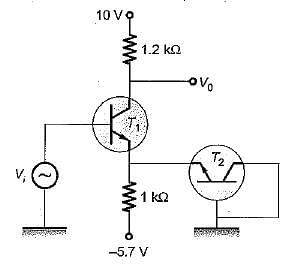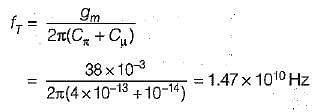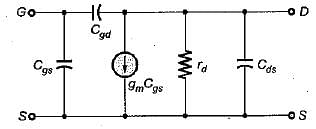Test: Frequency Response - Electronics and Communication Engineering (ECE) MCQ
10 Questions MCQ Test - Test: Frequency Response
The mid frequency gain of the amplifier circuit shown below with high value of beta of the BJT is


In a common source MOSFET amplifier circuit operating at 10 kH z, the drain resistance Rd = 200 kΩ. If MOSFET parameters are gm = 1.5 mA/V, r d = 50 kQ, Cds = 1.0 pF and Cgd = 2.0 pF, the voltage gain is equal to
| 1 Crore+ students have signed up on EduRev. Have you? Download the App |
An npn BJT has gm = 38 mΩ/V, Cμ = 10-14 F, Cπ = 4 x 10-13 F and DC current gain, β0 = 90. For this transistor fT and fβ are respectively
G iven for an FET, gm = - 9 .5 m A /volt, total capacitance = 500 pF. For a voltage gain of -30, the bandwidth will be
The drain gate capacitance of a junction FET is 2 pF. Assuming a common source voltage gain of 20, what is the input capacitance due to miller effect?
Assertion (A): In the high frequency model of FET, the voltage amplification drops drastically with increase in frequency.
Reason (R): The high frequency model is identical with the low frequency model except that the capacitances between various terminals (gate, source and drain) is added.
For a single stage CE amplifier, gm = 50 mA/V, Ce= 1 pF and Cc = 0.2 pF. The frequency at which the short circuit common-emitter current gain attains unit magnitude is given by
When the load resistance is zero (short circuit) in a common-emitter configuration, the current flowing from the base to the collector node through the collector capacitor Cc, is small because
Consider the following statements:
1. For finding the transistor behaviour at high frequency it is necessary to examine the diffusion mechanism.
2. At low frequency it is assumed that the transistor responds instantly to changes of input voltage or current.
3. The hybrid-jr model is valid under dynamic conditions when the rate of change of \/BEis small enough so that the base incremental current/^ is small compared with the collector incremental current/^
4. The parameter fTis a frequency characteristic of a transistor.
Which of the above statements are correct?
A modern bipolar transistor can have Ce = 1 pF. If gm = 50 mA/V, the fT of a common emitter amplifier will be


























